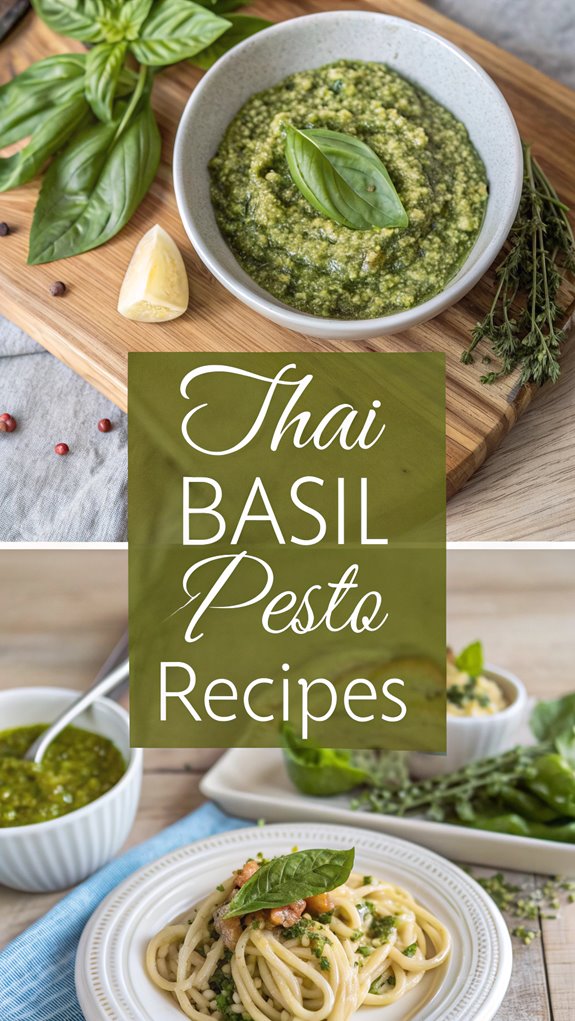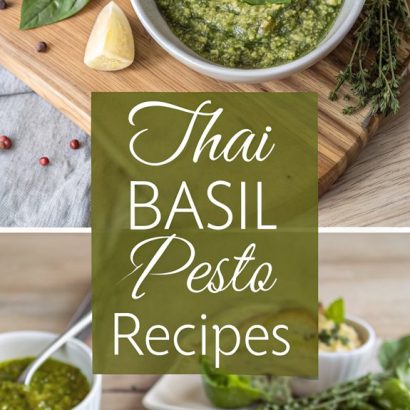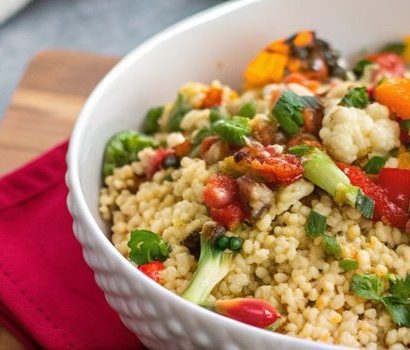Thai Basil Pesto Recipes
Thai basil pesto brings a fresh twist, elevates your dishes, and introduces unique flavors to your kitchen. You might find it surprising how simple ingredients like Thai basil, garlic, and nuts can transform into a versatile sauce. Whether you’re tossing it with pasta, using it as a marinade, or spreading it on bread, the possibilities are endless. But what if you could customize the heat and texture to suit your taste? Exploring the nuances of this recipe could lead you to unexpected culinary delights.
Why You’ll Love This Recipe
If you’re looking for a sauce that elevates your dishes without taking up too much time, you’ll love this Thai basil pesto.
Its versatility shines as you can use it on pasta, mix it into butter for a compound spread, or enhance mayonnaise and yogurt.
The quick preparation takes just 5-10 minutes, using simple ingredients like Thai basil, garlic, nuts, and olive oil. Pronounced licorice essence makes Thai basil unique, adding depth to the flavor profile of the pesto.
You won’t even need to chop anything; a food processor handles it all.
Plus, this vegan recipe is healthy, packed with antioxidants and fiber, and can be stored for up to a week.
With authentic Thai flavors from soy sauce and lime juice, it’s perfect for adding a spicy twist to your meals.
History
Thai basil pesto not only brings a contemporary twist to traditional recipes but also has a rich history that dates back centuries.
Basil was first introduced to Mediterranean countries from India through ancient spice routes. The Romans created a herb mixture called moretum, an early form of pesto. Italians in Liguria adapted this by adding basil and pine nuts, using local ingredients like olive oil.
The term “pesto” comes from the Italian word “pestare,” meaning to pound or crush. In 1863, Giovanni Battista Ratto published the first modern pesto recipe.
Over time, pesto has spread globally, inspiring variations like Thai basil pesto, which combines Asian flavors with traditional elements, showcasing culinary fusion and innovation. This adaptation highlights the cultural exchange that has led to diverse interpretations of pesto across different regions.
Recipe

Thai Basil Pesto Recipe
Thai Basil Pesto is a vibrant and flavorful twist on the traditional basil pesto, infused with the aromatic notes of Thai basil and a hint of heat from chilies. This unique blend of flavors creates a sauce that not only enhances pasta dishes but also serves as a delightful topping for proteins like grilled chicken or shrimp. The fusion of Asian and Italian cuisine in this pesto creates a truly distinctive flavor profile that sets it apart from traditional pestos.
The nutty crunch from the nuts and the rich undertones of cheese combine perfectly with the citrusy brightness from lime and lemon, making this pesto a must-try for any culinary enthusiast.
To make this Thai Basil Pesto, you’ll need a food processor or a mortar and pestle to bring all the ingredients together. The process is straightforward and can be completed in just a few minutes. Whether you’re preparing a quick weeknight meal or a delicious dish to impress guests, this pesto will add a burst of flavor to any plate. Let’s get started!
Ingredients
- 2-3 cups Thai Basil, packed
- 1/3 to 1/4 cup nuts (peanuts, cashews, almonds, or walnuts)
- 1/4 to 1/2 cup cheese (Parmesan, Parmigiano Reggiano, or Pecorino)
- 2-3 Thai green chilies or bird’s eye chilies
- 2-3 cloves garlic
- 2 tablespoons lime juice
- 1 tablespoon lemon zest
- 1 tablespoon lemon juice
- Olive oil or other neutral oil (as needed)
- Oyster sauce or fish sauce (optional, for umami flavor)
Cooking Instructions
- Begin by preparing all your ingredients. Wash the Thai basil leaves thoroughly to remove any dirt or grit. If using whole nuts, lightly toast them in a dry skillet over medium heat for a few minutes until fragrant.
- In a food processor or granite mortar and pestle, combine the dry ingredients first: the Thai basil, nuts, cheese, and chilies. Pulse or grind until the mixture is finely chopped and well combined.
- Next, add the garlic, lime juice, lemon zest, and lemon juice to the mixture. Continue to blend until the ingredients are fully integrated and smooth.
- While the processor is running, gradually drizzle in the olive oil or neutral oil of your choice until you achieve your desired consistency. If you prefer a thinner pesto, add more oil.
- If you’re using oyster sauce or fish sauce for added umami, stir it in at this stage, adjusting the amount to suit your taste preferences.
- Taste the pesto and adjust the seasoning if necessary. You can add more lime juice, salt, or chilies depending on your flavor preference.
- Transfer the pesto to an airtight container or mason jar. It can be stored in the fridge for up to 7 days or frozen for up to 6 months.
Extra Tips
When making Thai Basil Pesto, feel free to experiment with the nut and cheese combinations to discover your favorite flavor profile.
Keep in mind that the heat level can be adjusted by using more or fewer chilies, or even opting for milder peppers if preferred.
Additionally, for a creamier texture, consider blending in a bit of cream cheese or Greek yogurt. Always taste as you go to guarantee the balance of flavors is to your liking!
Final Thoughts
While exploring the world of flavors, you’ll find that Thai Basil Pesto stands out as a delightful and versatile addition to your culinary repertoire.
It’s rich in fat, mainly from oils and nuts, but low in protein and fiber, so balance it with other nutritious foods. Use it in salads, noodles, or as a marinade to enhance your meals with its sweet and spicy notes. The high fat content makes it a rich source of energy, which can promote satiety when included in your dishes.
You can adjust its texture easily by adding olive oil. Experiment with variations like adding garlic or mixing in other herbs for unique flavors.
When stored properly, Thai basil and its pesto can last longer, allowing you to enjoy this vibrant ingredient in many dishes.
Embrace its versatility and enjoy cooking!
FAQ
Have questions about Thai basil pesto? You might wonder about the ingredients. For the best flavor, use Thai basil, peanuts, lime juice, soy sauce, sesame oil, and garlic. Additionally, Thai basil’s distinct flavor adds a unique twist to the traditional pesto, enhancing its overall taste profile.
If you can’t find Thai basil, regular sweet basil works too. Feel free to swap peanuts for cashews or sunflower seeds if you’re looking for nut-free options.
When making it, blend all ingredients except the oil first, then slowly add the oil until you reach your desired texture. You can make it chunky or smooth, depending on your preference.
To store it, transfer the pesto to a sealed jar and keep it in the fridge. Finally, don’t hesitate to adjust flavors to suit your taste!

THAI BASIL PESTO RECIPES
Ingredients
- INGREDIENTS
- 2-3 cups Thai Basil packed
- 1/3 to 1/4 cup nuts peanuts, cashews, almonds, or walnuts
- 1/4 to 1/2 cup cheese Parmesan, Parmigiano Reggiano, or Pecorino
- 2-3 Thai green chilies or bird's eye chilies
- 2-3 cloves garlic
- 2 tablespoons lime juice
- 1 tablespoon lemon zest
- 1 tablespoon lemon juice
- Olive oil or other neutral oil as needed
- Oyster sauce or fish sauce optional, for umami flavor
Instructions
- COOKING INSTRUCTIONS
- Begin by preparing all your ingredients. Wash the Thai basil leaves thoroughly to remove any dirt or grit. If using whole nuts, lightly toast them in a dry skillet over medium heat for a few minutes until fragrant.
- In a food processor or granite mortar and pestle, combine the dry ingredients first: the Thai basil, nuts, cheese, and chilies. Pulse or grind until the mixture is finely chopped and well combined.
- Next, add the garlic, lime juice, lemon zest, and lemon juice to the mixture. Continue to blend until the ingredients are fully integrated and smooth.
- While the processor is running, gradually drizzle in the olive oil or neutral oil of your choice until you achieve your desired consistency. If you prefer a thinner pesto, add more oil.
- If you're using oyster sauce or fish sauce for added umami, stir it in at this stage, adjusting the amount to suit your taste preferences.
- Taste the pesto and adjust the seasoning if necessary. You can add more lime juice, salt, or chilies depending on your flavor preference.
- Transfer the pesto to an airtight container or mason jar. It can be stored in the fridge for up to 7 days or frozen for up to 6 months.



